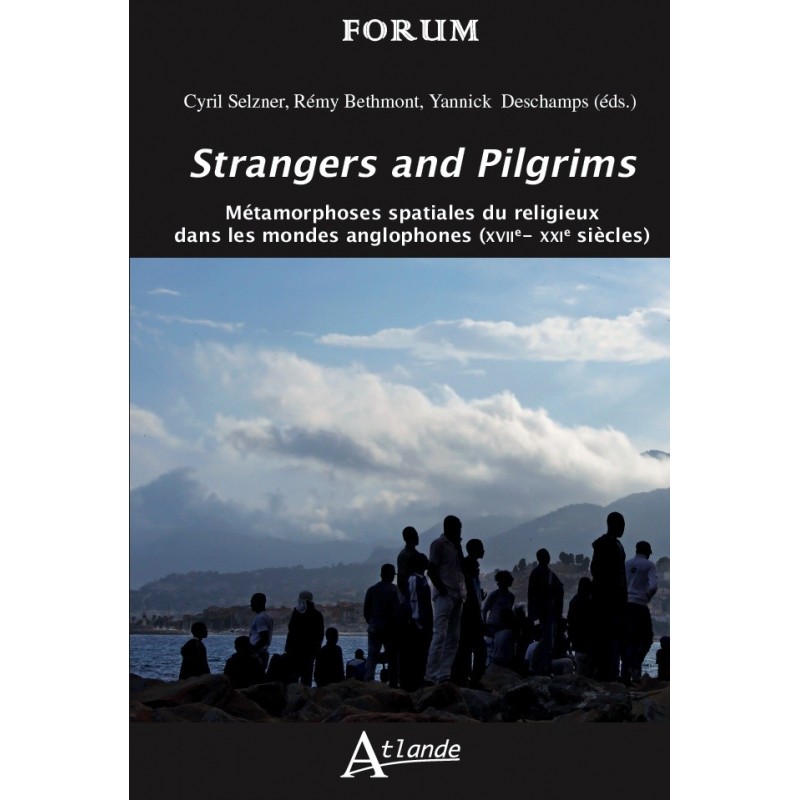



par Cyril Selzner, Rémy Bethmont, Yannick Deschamps (éds.)
 Livraison en lettre suivie
Livraison en lettre suivie
France met. : 5€ ⭢ 24€ d'achat, 10€ ⭢ 48€, 15€ ⭢ 96€, 20€ au-delà. DOM-TOM : 12€, 20€, 28€, 40€
Des pères fondateurs des États-Unis aux migrants d’aujourd’hui, le fil rouge de la foi dans l’exil.
L’ouvrage propose un riche parcours dans cette dualité entre religion et migration, à travers l’histoire des jésuites dans le Nouveau Monde, d’un évêque converti par des Zoulous païens, du pacifisme des quakers, du particularisme religieux des Canadiens français, mais aussi à travers le prisme de la littérature : la vision de l’hindouisme d’Alexander Dow, celle du pèlerin de Daphné du Maurier ou la position de l’Église anglicane d’Afrique du Sud chez Alan Paton. Le volume se conclut sur une analyse de l’image de la mosquée chez les Britanniques de culture musulmane et sur une comparaison éclairante entre l’exode des Highlanders écossais au Canada au XIXe siècle et des népaliphones du Bhoutan vers les pays occidentaux au XXIe siècle.
Fiche technique
INTRODUCTION
ÉTRANGERS SUR LEUR PROPRE TERRE : DÉRACINEMENT ET CONVERSION DES AMÉRINDIENS DANS LE MASSACHUSETTS DU XVIIe SIÈCLE (C. AUCLAIR)
DE L’ÉCOUTE DE DIEU À L’ÉCOUTE DE CHACUN, DE LA VERTICALITÉ EUROPÉENNE À L’HORIZONTALITÉ AMÉRICAINE : LES MISSIONNAIRES JÉSUITES À L’ÉPREUVE DU NOUVEAU MONDE, XVIIe-XXIe SIÈCLES (F. DOREL)
L’ÉVÊQUE CONVERTI PAR LES PAÏENS : JOHN WILLIAM COLENSO ET LES ZOULOUS (1853-1883) (J. GROSCLAUDE)
LES RELIGIEUSES ANGLAISES AU XVIIe SIÈCLE : UN DOUBLE EXIL POUR LA FOI (L. LUX-STERRITT)
TRANSATLANTIC TRANSFORMATIONS FROM NEW JERSEY TO LONDON: JOHN WOOLMAN AND THE QUAKER ABOLITIONISTS (1754-1772) (S. WATSON)
“TAKING THE RELIGION OF ‘SAINT JEAN BAPTISTE’”: EXPLORING NEW RELIGIOUS TERRITORIES AMONG FRENCH CANADIANS IN 19TH–CENTURY QUEBEC (C. HINAULT)
EXILE AND EPISTEMIC VIOLENCE IN ALEXANDER DOW’S ACCOUNT OF HINDUISM (P. RAY)
L’HUMILIATION DU PÈLERIN DANS “THE WAY OF THE CROSS” DE DAPHNE DU MAURIER (X. LACHAZETTE)
NO LONGER STRANGERS, YET PILGRIMS: THE SOUTH AFRICAN ANGLICAN CHURCH IN ALAN PATON’S CRY THE BELOVED COUNTRY (1948) (S. BRAY)
NEGOTIATING RELIGION, SECULARISM, AND PUBLIC SPACE IN BRITISH MUSLIM WRITING: LITERARY REPRESENTATIONS OF THE MOSQUE AS A HETEROTOPIC SPACE (L. AHRENS)
AFTERWORD – “UNDER THE SHADOW OF YOUR WINGS” (PS.17,8). THE ROLE OF RELIGIOUS BELIEF IN FLIGHT AND RE-SETTLEMENT (F. HOUSTON)
Rémy Bethmont, professeur d’Histoire et Civilisation britanniques à l’université Paris 8 Vincennes – Saint-Denis, Yannick Deschamps, maître de conférences en Civilisation britannique à l’université Paris-Est Créteil et Cyril Selzner, maître de conférences en Civilisation britannique et en Anglais économique à l’université Paris 1 Panthéon-Sorbonne, ont rassemblé une quinzaine d’universitaires, d’hommes d’Église et de responsables administratifs réunis par leur préoccupation commune des questions migratoires.
ALAN PATON’S PILGRIMAGE
When Alan Paton (1903-1988) started to write Cry the Beloved Country, shortly after the Second World War, he was 43 years old and had been an Anglican for 15 years. However, he had recently experienced a kind of conversion as a result of participating in Bishop Geoffrey Clayton’s Diocesan Commission, which was an attempt to discover “what it believed to be the mind of Christ for South Africa” [PATON, 1973, p. 117]. Although born in South Africa, as were his mother, his brother and his sisters, Paton had long been aware that his family did not feel South African and he deplored their “ultra-Britishness, [their] inordinate pride in the British Navy and [their] devotion to the royal family” [1980, p. 34]. He also had trouble understanding why his “father called Britain home, and [his] mother, who had never seen it, did likewise” [1980, p. 34]. This was all part of the paradox of a ruling class calling themselves and their children “European” [HUDDLESTON, 1956, p. 61] and not South African, while, as Trevor HUDDLESTON points out, also feeling obliged to “make sure that the native in the urban areas is, and knows he is, there on sufferance. That he has no permanence of any kind. That he is a migrant whose sole purpose is to provide labour” [1956, p. 51]. This was a reference to the hated Pass Laws which, ever since the Natives (Urban Areas) Act of 1923, required all black men in urban areas to carry a pass and stipulated when and how long they were allowed to remain there. The result of this legislation was that nobody felt fully at home in the land. From quite an early age, PATON understood instinctively that there was something wrong with the attitude behind such restrictions and he claims that, from the age of 21, he had “for better or worse given [him]self to this strange country, to love and to cherish till death did [them] part” [1980, p. 82] and he identified himself as South African. It is interesting here to note that, despite his love for it and commitment to it, Paton acknowledges that it is, to him, a “strange” country, and not a home with which he felt comfortable and familiar.